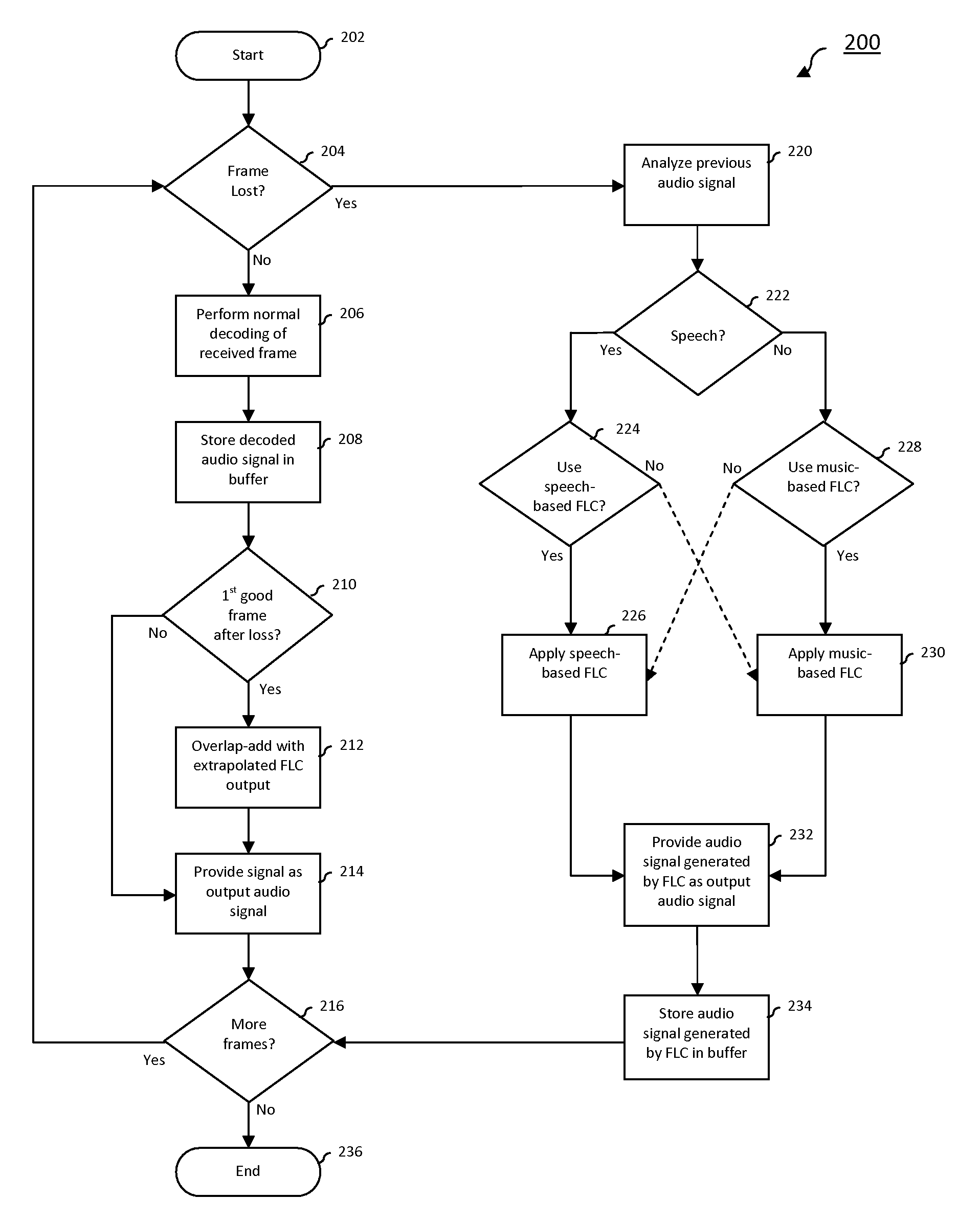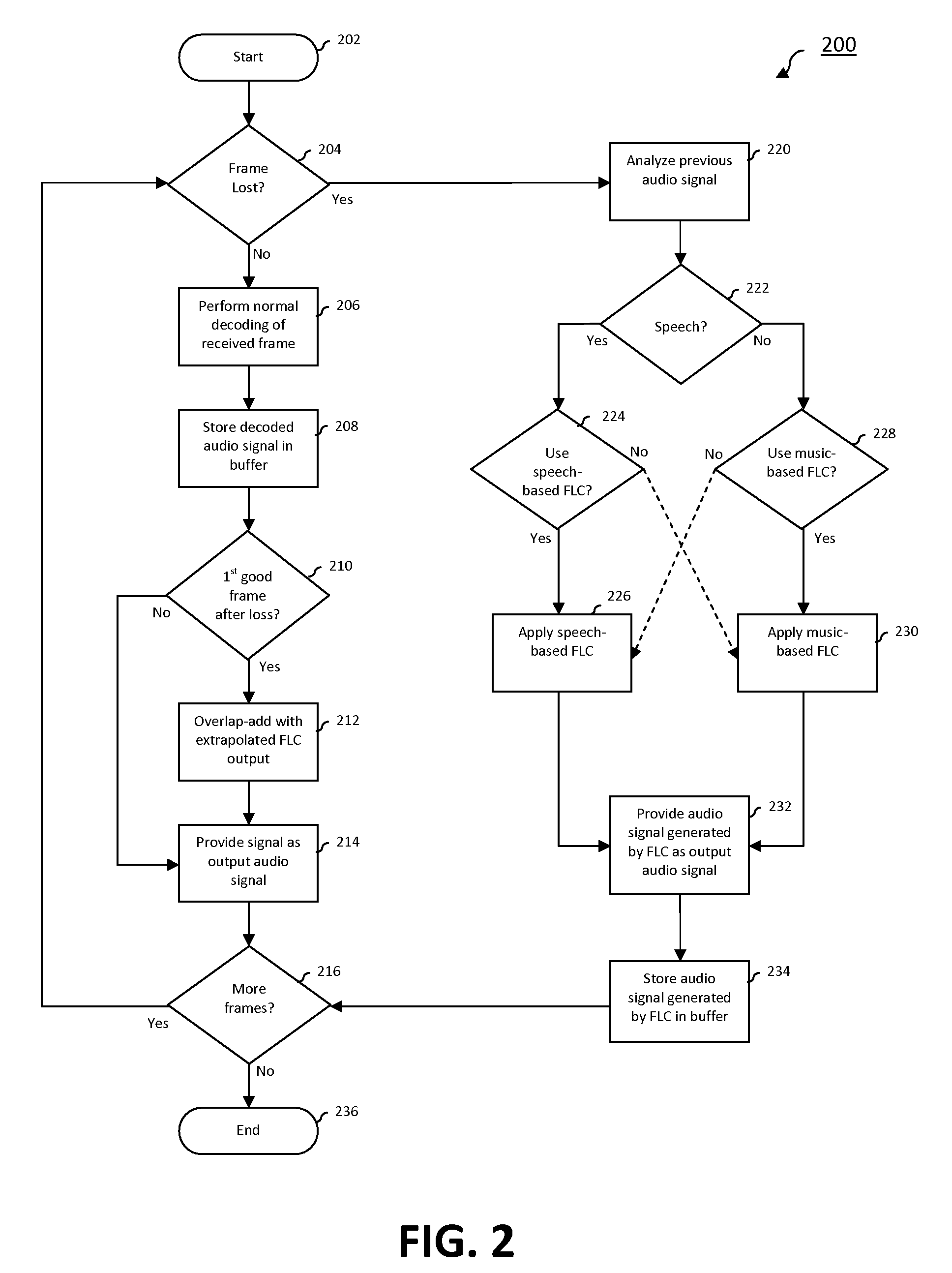Decimated Bisectional Pitch Refinement
a pitch refinement and bisectional technology, applied in the field of estimating a pitch period, can solve the problems of complex straightforward approaches, affecting the accuracy of pitch refinement, and presenting a significant complexity load in itself, so as to achieve low complexity
- Summary
- Abstract
- Description
- Claims
- Application Information
AI Technical Summary
Benefits of technology
Problems solved by technology
Method used
Image
Examples
first embodiment
1. First Embodiment
Overlapping Decomposed Signals with Decomposed Signals
[0224]In this embodiment, the signals for overlapping are decomposed into a correlated component, scout and scin, and an uncorrelated component, suout and suin. The overlapped signal s(n) is then given by the following equation (Equation C.1):
s(n)=[scout(n)·wcout(n)+scin(n)·wcin(n)]+n=0 . . . N−1
[suout(n)·wuout(n)+suin(n)·wuin(n)]
[0225]FIG. 16 shows a flowchart 1600 providing example steps for overlapping a first decomposed signal with a second decomposed signal according to the above Equation C.1. The steps of flowchart 1600 need not necessarily occur in the order shown in FIG. 16. Other structural and operational embodiments will be apparent to persons skilled in the relevant art(s) based on the discussion provided herein. For example, FIG. 17 shows a system 1700 configured to implement Equation C.1, according to an embodiment of the present invention. Flowchart 1600 is described as follows with respect to FI...
second embodiment
2. Second Embodiment
Overlapping a Mixed Signal with a Decomposed Signal
[0230]In this embodiment, one of the overlapping signals (in or out) is decomposed while the other signal has the correlated and uncorrelated components mixed together. Ideally, the mixed signal is first decomposed and the first embodiment described above is used. However, signal decomposition is very complex and overkill for most applications. Instead, the optimal overlapped signal may be approximated by the following equation (Equation C.2.a):
s(n)=[sout(n)·wcout(n)]·β+scin(n)·wcin(n)+n=0 . . . N−1
[sout(n)·wuout(n)]·(1−β)+suin(n)·wuin(n)
where β is the desired fraction of correlated signal in the final overlapped signal s(n), or an estimate of the cross-correlation between sout and scin+suin. The above formulation is given for a mixed sout signal and decomposed sin signal. A similar formulation for the opposite case, where sout is decomposed and Sin is mixed, is provided by the following equation (Equation C.2.b)...
third embodiment
3. Third Embodiment
Overlapping a Mixed Signal with a Mixed Signal
[0238]In this embodiment, both overlapping signals are not decomposed. Once again, a desired solution is to decompose both signals and use the first embodiment of subsection C.1 above. However, for most applications, this is not required. In an embodiment, an adequate compromise solution is given by the following equation (Equation C.3):
s(n)=[sout(n)·wcout(n)+sin(n)·wcin(n)]β+n=0 . . . N−1
[sout(n)·wuout(n)+sin(n)·wuin(n)]·(1−β)
where β is an estimate of the cross-correlation between sout and sin. Again, notice that if the signals are completely correlated (β=1) or completely uncorrelated (β=0), the solution is optimal.
[0239]FIG. 20 shows a flowchart 2000 providing example steps for overlapping a mixed first signal with a mixed second signal according to the above Equation C.3. The steps of flowchart 2000 need not necessarily occur in the order shown in FIG. 20. Other structural and operational embodiments will be appare...
PUM
 Login to View More
Login to View More Abstract
Description
Claims
Application Information
 Login to View More
Login to View More - R&D
- Intellectual Property
- Life Sciences
- Materials
- Tech Scout
- Unparalleled Data Quality
- Higher Quality Content
- 60% Fewer Hallucinations
Browse by: Latest US Patents, China's latest patents, Technical Efficacy Thesaurus, Application Domain, Technology Topic, Popular Technical Reports.
© 2025 PatSnap. All rights reserved.Legal|Privacy policy|Modern Slavery Act Transparency Statement|Sitemap|About US| Contact US: help@patsnap.com



